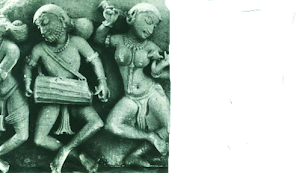Tabla - Its History

Tabla
A tabla is a pair of drums that are played while seated on
the ground. The larger drum, known as Bayan, was once made of clay but is now
made of brass, steel, and copper Metals. Also made using strong woods like
rosewood, neem, sandalwood, teak etc.
The Tabla is classified as the following:-
- Tabla – A Tabla is usually made using
strong woods like rosewood, neem, sandalwood, teak etc.
- Pudi - The shell from which the tabla is
overlaid is called poodi or Pudi. A Pudi is mostly made of goatskin. Tighten it
on the tabla with a bhadi (wooden pieces) or a rope.
- Syahi -The black patch that remains in the middle of the ink-poodi
is called ink. The black Patch ( ink-like substance) is kept circular.
- Chati - There is a double strip on the
edge around the chauti-poodi which is called Chati. The bhol (referred to as
the sound produced by the tabla) come out with the stroke of a finger on the
Chati.
- Maidan - The space between the black ink
and the Chati is called a Maidan.
- Gajra -
There is a leather gajra around the poodi, in which there are holes. Through
these holes, the webbing is tied and the gajra is used to loosen & tighten
the Tabla. And it is used in Tightening
or loosening it down simultaneously hitting the Tabla.
- Baddhee-poodee: The leather string that is used
to tighten the tabla on the webbing is called
baddhee.
- Gatte- There are eight wooden Gattas for
raising or taking down the tabla. These knots are fixed in the middle of the
webbing.
The right tabla is mostly tuned with the Shadaj (the first
note} or Pancham Swar {the 5th Note}. In a raga in which the first
note is not heard, the right tabla is mixed with the middle note. The left
tabla is mostly raised or docked sometimes it is mixed with Shadj the first
note.
A hammer is used to raise or lower the tabla. First of all,
the tone of the tabla is played and it is seen that on the day it is seen
whether the tone in which it is to be mixed is harmonic to the tone If it is
lowered, then the bata of the tabla should be backwards, due to which the tone
of the tabla is high. There are two ways of thumping the gattas of the tabla - the first is that all the gattas are knocked one after the other and the second is
that one gatta is thumped.
Nativity of Tabla
In
Hinduism and Sikhism's bhakti devotional traditions, such as bhajan and kirtan
singing, the tabla is an essential instrument. Sufi musicians utilise it as one
of the principal qawali instruments. Tabla is also used in Kathak dance
performances.
The tabla is made up of cutting two parts of
Pakhawaj, each of which is hollowed out of wood, clay or metal and has a
slightly different size and shape. The smaller drum (Dayan) is left-handed is
utilised to produce treble and tonal sounds, while the larger drum (baya) is right-handed is mostly used to produce bass. On the sides, they're strung with hoops, thongs,
and wooden dowels. The dowels and hoops are used to tune the drums by
tightening the membrane tension.
According to the Indian perspective, the table’s
origins can be traced back to an ancient indigenous culture. Some have claimed
that the stone sculpture engravings in Baja Caves portray a woman playing a
pair of drums as proof of the table’s ancient Indian origins. A
variant version of this storey claims that the tabla evolved from ancient
Indian puskara drums and was given a new Arabic name during Islamic Regime.
Many
temple sculptures, such as the Ajantha-Ellora caves and the temples of
Mahabaleshwaram & Konark Sun Temple and many other temples in India, show
traces of hand-held instruments like Veena, Flute, Gattam, Mridangam, Pakhawaj, Dolaks
so on & so forth.
These
works of art depict drummers seated with two or three Small drum-like instruments in their hands, palms
and fingers positioned as if playing them. However, none of these ancient
sculptures indicates that the drums were made of the same material and skin as
the current tabla or that they played the same melody.
Origin
of Tabla -
*According to the Book of Music Sangeet Shastra Darpan By the author Smt. Shanti Gowardhan
The tabla was not invented
in ancient times to play the rhythm. It is said that at the time when the demon
Vritrasura was killed by Lord Shankar, during the festival of joy, Shri Ganesha
played by digging a pit on the earth, covering Vritrasura's skin with it.
This
gives some idea about the origin of the percussion instrument.In
ancient times, the instruments which were used to play the rhythm are as
follows - - Ghat
- Dundubhi
- Pride
- Vanaspati
- Mridang
- Shari
- Dimdim
Some
people are of the view that the ancient instrument called Durdur has a lot in
common with the modern tabla.
Amir
Khusrau (16th century) has an important place in the field of music. Many
scholars believe that it was Khusru Sahib who invented the modern tabla. He
divided the pakhawaj into two parts. Thus two forms of tabla (left and right)
were invented. The second place in the field of tabla belongs to Ustad Siddar
Khan of Delhi. He is considered to be the most loved master of tabla and he
made many improvements in tabla playing which are important.
To Conclude
After
the 16th century, singers of Dhrupad etc. were accompanied by Mridang or
pakhawaj only. Even today some singers prefer the accompaniment of Pakhawaj
with Dhrupad. But in modern times, the promotion of tabla is increasing day by
day as compared to Mridang and pakhawaj.
Thank You
 |
| Tabla |
The Tabla is classified as the following:-
- Tabla – A Tabla is usually made using
strong woods like rosewood, neem, sandalwood, teak etc.
- Pudi - The shell from which the tabla is
overlaid is called poodi or Pudi. A Pudi is mostly made of goatskin. Tighten it
on the tabla with a bhadi (wooden pieces) or a rope.
- Syahi -The black patch that remains in the middle of the ink-poodi
is called ink. The black Patch ( ink-like substance) is kept circular.
- Chati - There is a double strip on the edge around the chauti-poodi which is called Chati. The bhol (referred to as the sound produced by the tabla) come out with the stroke of a finger on the Chati.
- Maidan - The space between the black ink
and the Chati is called a Maidan.
- Gajra - There is a leather gajra around the poodi, in which there are holes. Through these holes, the webbing is tied and the gajra is used to loosen & tighten the Tabla. And it is used in Tightening or loosening it down simultaneously hitting the Tabla.
- Baddhee-poodee: The leather string that is used
to tighten the tabla on the webbing is called
baddhee.
- Gatte- There are eight wooden Gattas for
raising or taking down the tabla. These knots are fixed in the middle of the
webbing.
A hammer is used to raise or lower the tabla. First of all, the tone of the tabla is played and it is seen that on the day it is seen whether the tone in which it is to be mixed is harmonic to the tone If it is lowered, then the bata of the tabla should be backwards, due to which the tone of the tabla is high. There are two ways of thumping the gattas of the tabla - the first is that all the gattas are knocked one after the other and the second is that one gatta is thumped.
Nativity of Tabla
Origin of Tabla -
*According to the Book of Music Sangeet Shastra Darpan By the author Smt. Shanti Gowardhan
The tabla was not invented
in ancient times to play the rhythm. It is said that at the time when the demon
Vritrasura was killed by Lord Shankar, during the festival of joy, Shri Ganesha
played by digging a pit on the earth, covering Vritrasura's skin with it.
- Ghat
- Dundubhi
- Pride
- Vanaspati
- Mridang
- Shari
- Dimdim
Amir
Khusrau (16th century) has an important place in the field of music. Many
scholars believe that it was Khusru Sahib who invented the modern tabla. He
divided the pakhawaj into two parts. Thus two forms of tabla (left and right)
were invented. The second place in the field of tabla belongs to Ustad Siddar
Khan of Delhi. He is considered to be the most loved master of tabla and he
made many improvements in tabla playing which are important.
To Conclude
After
the 16th century, singers of Dhrupad etc. were accompanied by Mridang or
pakhawaj only. Even today some singers prefer the accompaniment of Pakhawaj
with Dhrupad. But in modern times, the promotion of tabla is increasing day by
day as compared to Mridang and pakhawaj.
Thank You
.jpg)








Social Plugin